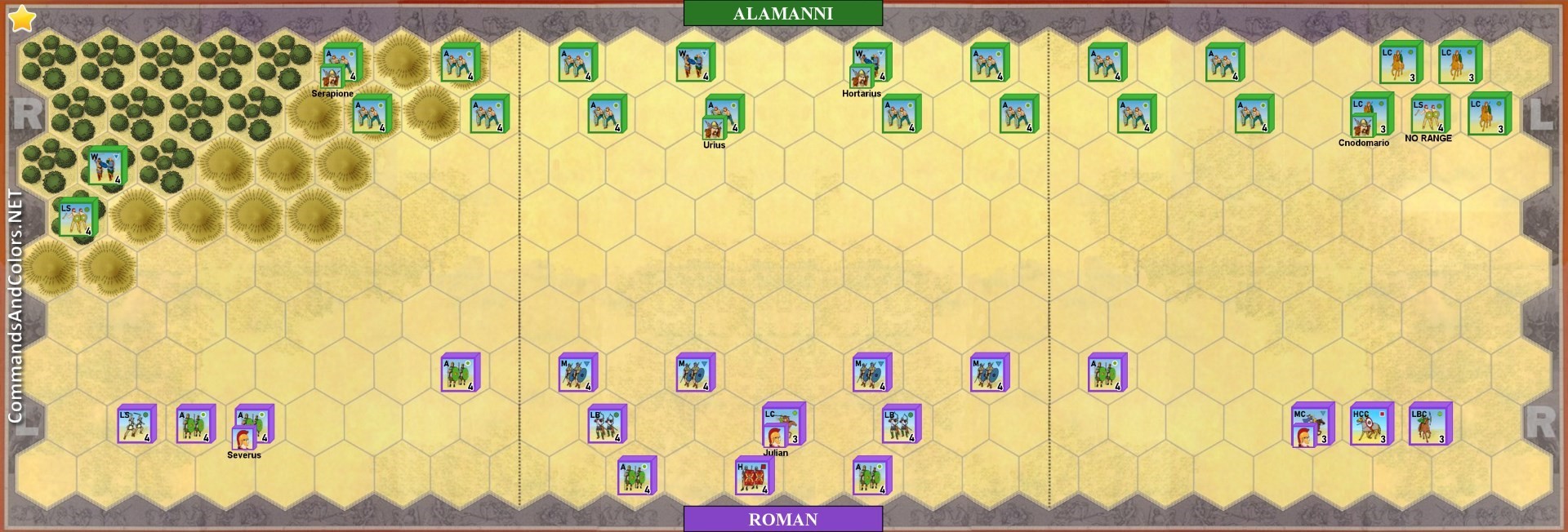Historical Background
The Battle of Strasbourg, also known as the Battle of Argentoratum, was fought in 357 between the Late Roman army under the Caesar (deputy emperor) Julian and the Alamanni tribal confederation led by the joint paramount king Chnodomar. The battle took place near Strasbourg (Alsace, France), called Argentoratum in Ammianus Marcellinus' account, Argentorate in the Tabula Peutingeriana (Section 2). Although probably outnumbered by a substantial margin, Julian's army won a complete victory after a hard-fought struggle. With negligible casualties of their own, the Romans drove the Alamanni beyond the river Rhine inflicting heavy losses. Julian's force, the imperial escort army of Gaul, was small but of high quality. The battle was won by the skill of the Roman infantry, with the cavalry initially performing poorly.
The battle was the climax of Julian's campaigns in 355-7 to evict barbarian marauders from Gaul and to restore the Roman defendefensive line of fortifications along the Rhine, which had been largely destroyed during the Roman civil war of 350-3. In the years following his victory at Strasbourg, Julian was able to repair and garrison the Rhine forts and impose tributary status on the Germanic tribes beyond the border.
The stage is set. The battle lines are drawn and you are in command. Can you change history?

Alammanic OOB: The Alammanic Army (SW Germany) was a force of some 25.000 men.
Romans OOB: The Roman Army was a force of some 12.000 men of infantry and 3000 cavalry.
Scale: Each romans and alammanic unit represent about 1000 infantry or cavalry. Each block represent about 250 infantry or 300 cavalry.
War Council
Roman Army
Leader: Suetonius Paulinus
Take 9 Command cards.
Victory
10 Banners
Special Rules
· Imperial Legions rules is in effect for Romans.
· The light cavalry with the leader Julian Roman is composed of a single block (cavalry escort the Consul).
· At a time when the Alammanic conquered 2 Banners, the Alammanic player rolls 2 dice at the beginning of each turn. With a double-shot, except the symbol of swords, he can activate the 4 units hidden in the forest (left sector). This units are activate if attacked by romans (ranged or close combat).
· Charge of the warriors: The infantry alammanic, if moved, must always move forward 3 hexes, toward the Roman units, and they can not to do ranged combat. When a unit alammanic is in contact for the first time with Roman armies, the "charge" ends then it can move as he wishes.
· The light infantry Alammanic, placed with the cavalry, is a special unit. It does not have missile weapons, so can not make ranged combat; when he comes in contact with enemy cavalry, however, it does Close Combat with a throw of 3 dice and once with the symbol of sword (historically Alammannic trained this unit to hit the legs of horses enemies).
